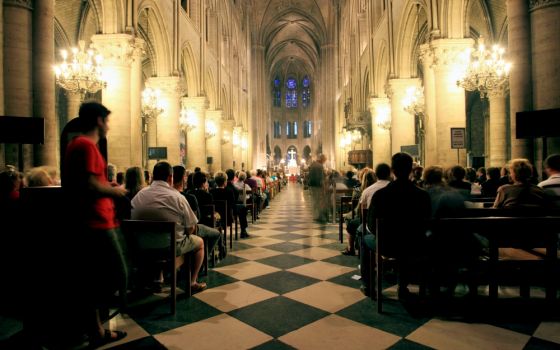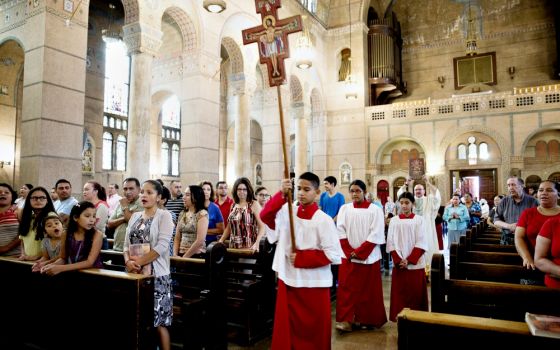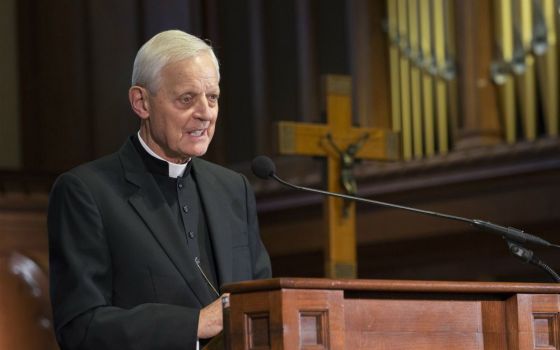Editor's Note: This article appeared in the May 25, 2001 issue of NCR.
Rome -- Authors of Vatican documents face the unenviable task of issuing orders and crafting arguments at the same time. Their texts must command, because they express the rules of the church; but they must also persuade, because otherwise people expected to follow those rules may balk.
In the case of Liturgiam Authenticam, a Vatican document issuing new rules on liturgical translation, the orders seem clear enough, but how persuasive they will be remains to be seen.
Critics say the document, issued May 7, strikes at the heart of Vatican II ecclesiology by centralizing power in the curia and by insisting that local cultures adopt an essentially Roman style of worship.
“Liturgiam Authenticam is a form of Western Colonialism masquerading as ecclesial unity,” said Viatorian Fr. Mark Francis, a liturgical scholar who has worked on translations for the English-speaking world.
Francis argued that while the Second Vatican Council (1962-65) envisioned the use of vernacular languages as a first step toward liturgies that reflect local cultures, Liturgiam Authenticam demands a uniform Roman model. He questioned assertions that the document is the fruit of 35 years of liturgical experience after Vatican II.
“It doesn’t reflect those 35 years,” Francis told NCR. “It wants to wipe them out.”
Liturgiam Authenticam demands that translators stick closely to the Latin originals of liturgical texts. It effectively repeals a 1969 Vatican document that afforded translators wide latitude in using words and phrases appropriate to the various vernacular languages.
The 1969 document, Comme le prévoit, endorsed an approach that came to be known as dynamic equivalency. The approach quickly became dominant in the English-speaking Catholic world.
In recent years, Rome has signaled a shift away from Comme le prévoit, rejecting or revising several translations that reflected its principles.
Examples of wording now likely to be changed include saying “and with your spirit” instead of “and also with you” when the priest says “peace be with you” during the Mass, or saying “I believe” rather than “we believe” at the beginning of the Creed.
The idea, according to Liturgiam Authenticam, is to foster a “sacred style” of liturgical speech. A related aim is to avoid wording “that the Catholic faithful would confuse with a manner of speech of non-Catholic ecclesial communities or of other religions.” Such similarities could lead to “confusion or discomfort,” according to the new document.
Most controversially for English speakers, the norms limit use of inclusive language, or vocabulary that is not gender-specific. Thus “for us” would not be an acceptable adaptation of “for us men” in the Creed.
A Vatican official who spoke to NCR on condition that he not be identified said, however, that Liturgiam Authenticam is not a power grab. Instead, he said, it’s a way of making sure that the Vatican is a partner in the translation process. Existing systems often tried to exclude a role for Rome, he said.
“The hope now is that the Holy See will be involved from the beginning, so we won’t have to say no at the end,” the official said. “We don’t just want to control things. It’s not Genghis Khan sitting over here waiting to send out the horses.”
The official rejected charges that the Vatican is undercutting collegiality or the authority of bishops and bishops’ conferences.
“I have never followed the reasoning behind a theory of collegiality that excludes the head of the college or his representatives,” he said, referring to the traditional understanding that the pope is the head of the college of bishops.
The official also argued that since the pope uses liturgical texts as translated into the vernacular languages, the Vatican has a legitimate interest in the quality of those translations.
Other critics of the dynamic equivalency approach, who regard it as a way for translators to inject their own biases into texts, were predictably heartened.
Jesuit Fr. Joseph Fessio of San Francisco , a leading critic of the approach adopted by ICEL, said the Vatican document will prevent “both a Balkanization into national or ethnic churches, and a cultural imperialism in which elites from the First World impose their idiosyncracies on less influential nations.”
Others, however, argue that the Vatican’s insistence on a stronger role in shaping liturgical language, reflected in Liturgiam Authenticam, contravenes the intentions of Vatican II.
“To not inculturate is to die,” said Jesuit Fr. Keith Pecklers, who teaches at Rome’s prestigious Pontifical Liturgical Institute.
Pecklers predicted that Liturgiam Authenticam “will be strongly critiqued” by professionals “for its lack of collegiality and its inconsistencies with Vatican II principles.” Ultimately, he said, the document may have “a very short shelf life.”
Capuchin Fr. Ed Foley, a liturgical expert in Chicago, said the document has “an overriding concern for procedures and control.” He pointed out that Liturgiam Authenticam mentions no fewer than 30 times the Vatican’s power to grant a recognitio, or approval, to translations.
Fr. James Moroney, chief of staff for the U.S. bishops’ committee on liturgy, insisted that Liturgiam Authenticam does not signal a rollback on Vatican II’s vision.
“The document is trying to assure an authentic inculturation by which the immemorial rites and prayers of the church are made available in the vernacular languages,” he said.
Moroney, a consultor to the Vatican office on liturgy, spoke to NCR in Rome.
“Liturgiam Authenticam is a direct, organic development of the vision of the council fathers,” he said.
Moroney said it’s important not to overreact. Liturgiam Authenticam still permits a “moderate” use of inclusive language, such as translating the Greek for “brothers” in the letters of Paul as “brothers and sisters.”
Advertisement
The Vatican official said that, in some instances, Rome has blocked inclusive language precisely out of a concern for inclusivity. He offered the example of “for us men” rather than “for us.”
“Who is the ‘us’ in the second sentence?” he said. “If you think about it, that expression is open to the worst kind of exclusivist interpretation. It could mean ‘us white middle-income Americans.’ ”
A particular concern of Liturgiam Authenticam is the status of “mixed commissions,” or translation bodies created as joint projects of several bishops’ conferences. The most controversial has been the International Commission on English in the Liturgy, sponsored by 11 English-speaking conferences, including the United States. The commission has been faulted for an excessively liberal approach to translation, especially with inclusive language.
Dominican Fr. Frank Quinn, a liturgical scholar in St. Louis, told NCR he sees Liturgiam Authenticam as “the end of the commission as we have known it.” Quinn said he regarded this as a “profoundly sad” development.
Moroney argued that the document is not “intended as an attempt to kill any individual commission,” but acknowledged that it codifies Vatican power “to define a commission’s statutes, its philosophy, and its way of life.”
Another bone of contention with Liturgiam Authenticam is what some critics see as a lack of consultation. Among bishops criticizing the process, Bishop Maurice Taylor, Scotland’s representative to the International Commission on English in the Liturgy, has complained that bishops’ conferences were not consulted in advance.
Bishop Peter Cullinane, New Zealand’s delegate to the commission, was quoted in the newspaper of his dioceses, as saying, “For more than two years, the bishops appointed to represent the English-speaking countries have tried to meet with the Congregation for Divine Worship to discuss these matters. The various excuses given for not meeting are an interesting study in themselves. They have nothing to do with collegality.”
Moroney, however, said that the U.S. bishops’ committee on the liturgy had carried out a consultation on translation, the results of which were taken into consideration in work on Liturgiam Authenticam.
One immediate question is what impact Liturgiam Authenticam will have on the English translation of the Sacramentary, the collection of prayers for the Mass, currently awaiting action in Rome. Sources said it is certain to introduce “new factors” resulting in additional delays.
At its most basic level, the Vatican official said, the goal of Liturgiam Authenticam is to preserve a special, elevated language for the public worship of the church, what he called “the linguistic equivalent of sacred space.” Ideas in the texts, both biblical and liturgical, are something the church has to offer the world,” he said, which means “pushing the vernacular language to places it has not gone before.” The official cited the King James Bible as an example.
The argument was not persuasive for Pecklers.
“The problem with the document is that it critiques ideologies, but is itself heavily ideological. It does not represent the mainstream of the Catholic church in the post-conciliar years,” Pecklers said.
“It sticks out like a sore thumb.”
The clash of views seems destined to continue. Sources told NCR that a group of cardinals hopes to raise Liturgiam Authenticam in the context of a larger debate over collegiality during a special consistory in Rome May 21-24.
[In 2001, John L.Allen was NCR's Vatican correspondent.]








